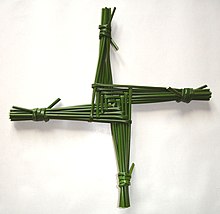Brigid
Brigid [ 'bʲɾʲiʝidʲ ] (as Old Irish , also Brighid or Brig , Scottish Bride , neuirisch Bríd ) is in the Celtic mythology of Ireland the name of a goddess . Her sanctuary was in Kildare ( Ireland ), where her sacred fire was kept. Her Welsh name is Ffraid ; for it is also the St Brides Bay (Welsh Bae Sain Ffraid ) in the west of Pembrokeshire in Wales named.
Etymology and Mythology
Her name is interpreted as "the bright one", "the shining one" or "the warrior" and goes back to an old Celtic goddess named Brigantia or Brigindo, the tribal deity of the Celtic brigands . The Germanic Perchta and perhaps the Welsh Ceridwen are also related to it . Some authors speculate about a (controversial) identification of Brigid with Danu or Anu .
Brigid is considered in the legend Cath Maige Tuired about The Second Battle of Mag Tuired as the daughter of Dagda and wife of Bress and as the mother of Ruadan . She is said to have been a personification of poetry and protector of the poets and was venerated in three guises, which is why the "three Brigids" are sometimes mentioned. Together with her two “sisters”, she is also seen as the patron goddess of the legislature, the healing arts, fertility and the blacksmiths. The distribution of the different functions between the three varies. The Brega plain was also named after her. In honor of Brigid, the festival of Imbolc was celebrated in Ireland , which later coincided with Candlemas .
Some authors suspect that Saint Brigida of Kildare did not exist and that it was a transformation (euhemerization) of the Celtic goddess into a Christian saint. However, one scientist (Lisa M. Bitel, University of Kansas ) is more likely to believe that the goddess Brigid was invented to denounce Brigida of Kildare as pagan / nonexistent and to make Patrick of Ireland a strong competitor off the neck.
Imbolc
Imbolc, which was celebrated from the night of February 1st to February 2nd, was an old Irish spring festival of herds and fertility, but is too, since it is between winter solstice and spring equinox at a solar declination of 16 degrees held for an ancient astrological festival. The processions of lights and the consecration of candles for Candlemas are originally based on old folk customs.
See also
- List of Celtic gods and legendary figures
- Celtic religion
- Myths and legends from Ireland
- Celtic women
literature
- Helmut Birkhan : Celts. Attempt at a complete representation of their culture. 2nd corrected and enlarged edition. Publishing house of the Austrian Academy of Sciences, Vienna 1997, ISBN 3-7001-2609-3 .
- Myles Dillon, Nora Kershaw Chadwick : The Celts. From the prehistory to the Norman invasion. Parkland-Verlag, Cologne 2004 (first 1966), ISBN 3-89340-058-3 , (Kindler's cultural history).
Web links
Individual evidence
- ↑ Myles Dillon, Nora Kershaw Chadwick: The Celts. From the prehistory to the Norman invasion . Parkland-Verlag, Cologne 2004 (first 1966), ISBN 3-89340-058-3 (Kindlers Kulturgeschichte), p. 260.
- ↑ Helmut Birkhan: Celts. Attempt at a complete representation of their culture. Publishing house of the Austrian Academy of Sciences, Vienna 1997, ISBN 3-7001-2609-3 , p. 537.
- ↑ Helmut Birkhan: Celts. Attempt at a complete representation of their culture. Publishing house of the Austrian Academy of Sciences, Vienna 1997, ISBN 3-7001-2609-3 , p. 615 f.
